-
Car Reviews
- All reviews
- Midsize SUVs
- Small cars
- Utes
- Small SUVs
- Large SUVs
- Large cars
- Sports SUVs
- Sports cars
- Vans
Latest reviews
- Car News
-
Car Comparisons
Latest comparisons
- Chasing Deals
Hybrid 11th-generation Civic arrives with a sparkling chassis and excellent fuel economy, but is $55,000 pushing the friendship too much?
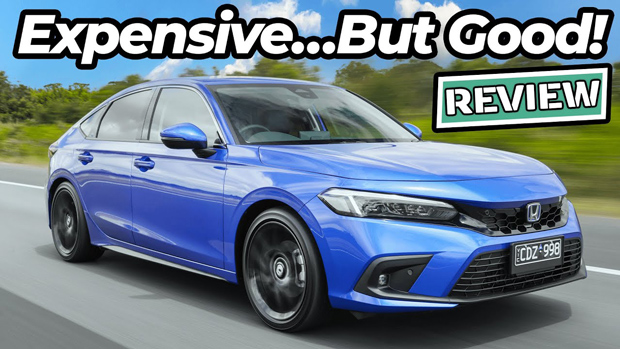
For those not yet ready to join the electric vehicle revolution, there’s now a fuel-sipping hybrid Honda Civic pushing the limits of efficiency: the e-HEV LX 2023.
Slotting in above the turbo-petrol 1.5-litre VTi LX and below the new, high-performance Type R, the e-HEV LX is Honda’s premium hybrid offering for those wanting to do their bit for the ever-warming climate – without any EV range anxiety.
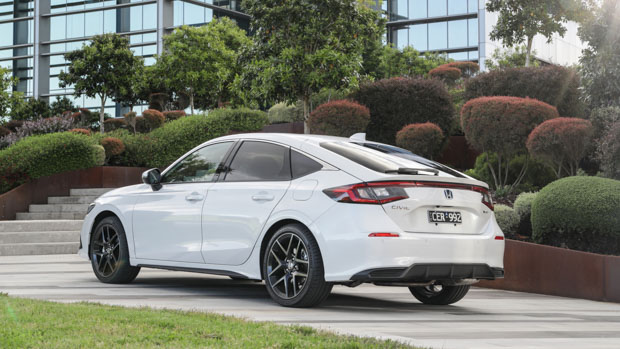
With a high-tech hybrid powertrain and oodles of standard equipment, the new e-HEV LX pushes the limits of pricing for Honda’s once-humble Civic, too. At $55,000 driveaway, the e-HEV LX is $7800 more expensive than the turbo petrol VTi LX, itself fairly pricey at $47,200 driveaway.
Honda has worked hard to build the case for the price premium (as we’ll get to). Its pitch is not merely just about added fuel economy.
On the tech front, there’s some clever engineering at work. While Honda says the Civic e-HEV uses an “eCVT”, it actually has no transmission.
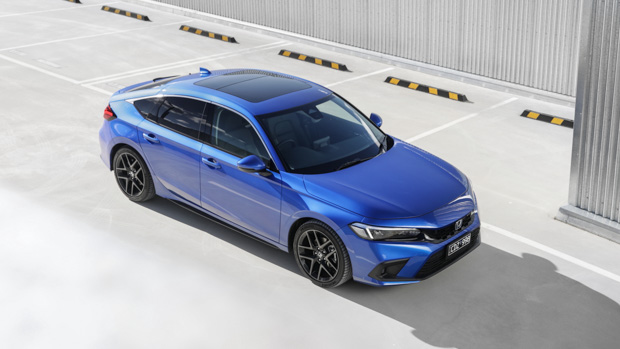
There are two electric motors sandwiched into the transmission housing. At lower speeds, the car is powered exclusively by one of the electric motors, providing 135kW of power and 315Nm of torque.
The other electric motor is merely a generator connected to the engine, which charges the small, rear-mounted 1.05kWh battery as required.
However, at “cruising speeds” such as on the motorway, a small lock-up clutch engages to connect the engine directly to the wheels using a 1:1 gear ratio. At highway speeds, the eHEV is constantly switching between electric motor and engine depending on demand – seamlessly, we might add.
The engine itself is a 2.0-litre naturally aspirated inline-four producing 105kW at 6000rpm and 186Nm at 4500rpm.
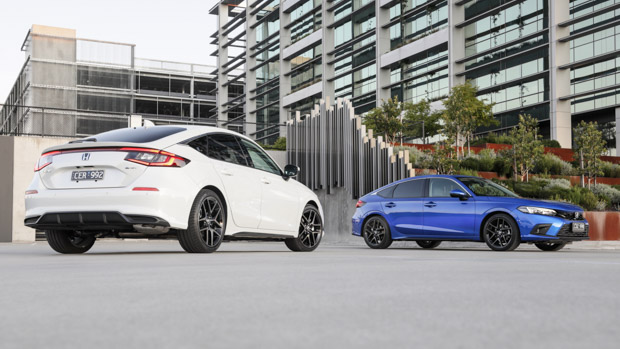
Appearance wise, the easy way to tell the difference between the turbo-petrol VTi LX and atmo-hybrid e-HEV LX are the exhaust tailpipes – the e-HEV has none, visibly at least. The e-HEV also has blue-accented Honda badges.
The e-HEV is not the first hybrid Civic, either – the last one was discontinued in Australia about 10 years ago, after a mass culling of hybrid Honda models also saw the exiting of the hybrid Jazz, Insight and CR-Z.
Honda has recently committed to offering hybrid variants across its entire range.
The Type R will complete the three-strong 11th-generation Civic lineup when it arrives in Australia in early 2023.
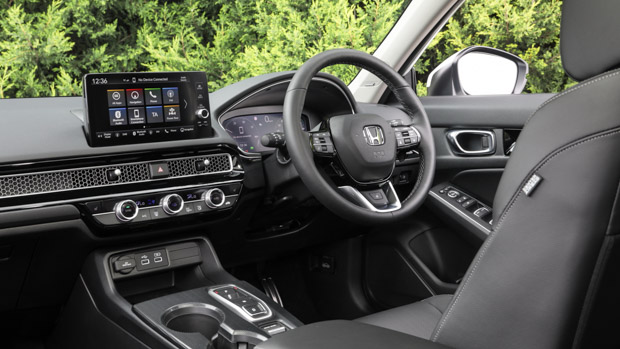
The VTi LX is loaded with standard equipment, and the e-HEV LX only adds even more in an effort to justify the bigger price.
As well as the slightly more powerful and much more fuel efficient hybrid powertrain, the additional $7800 gets you:
The e-HEV also comes with a five-year complimentary subscription to Honda’s new Connect app. The car uses a mobile network and certain functions can be controlled using an app on your phone.
For example, on a hot day, you can pre-cool the interior or on a cool day, you can pre-heat it. You can also remotely lock and unlock the car, view its logged driving history, track where the car is by GPS (if it gets stolen) and even set-up a notification for if the car exceeds a certain speed.
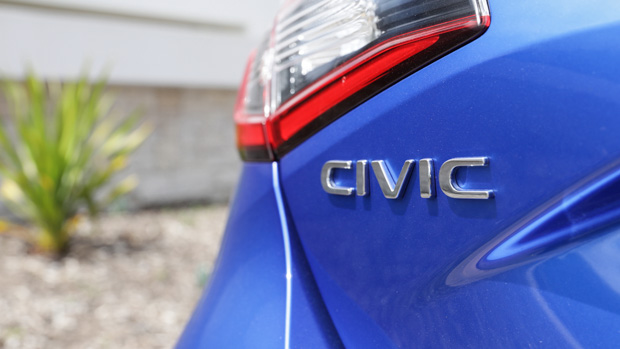
The e-HEV also gets Honda’s new smart keycard, not yet available on the VTi LX. The latter has keyless entry, but uses a smaller, more conventional key fob.
Both the VTi LX and e-HEV LX come with a 12-speaker Bose premium sound system.
At low speeds – like a carpark or driveway manoeuvring – the e-HEV feels like an electric car.
That’s especially if the little battery has a bit of charge in it already, and you are operating without the engine and only the electric motor. It’s near silent, save for an external speaker that makes a low din to warn pedestrians that it’s approaching.
You also get all the lovely attributes of an electric car: the buttery smooth acceleration and the delightfully seamless, instant switching between drive and reverse.
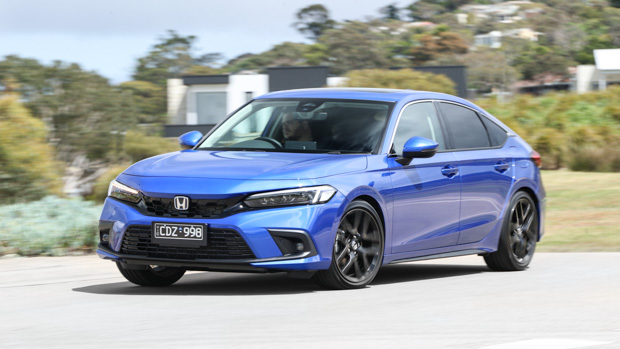
Compared to the VTi LX, the e-HEV LX uses shift-by-wire transmission selection, which means designers can use buttons instead of a lever for shifting from Park, to Reverse or Drive.
Honda’s interior designers have created an excellent, clever, effortless push-button transmission interface. It makes a surprising improvement to the everyday driving experience.
The Civic e-HEV LX is a rare example of a vehicle that, within about a kilometre of driving, you know is a great car. It just feels ‘right’, and fits the driver like a beautifully made glove. All the controls are light and easy to use, and feel lovely.
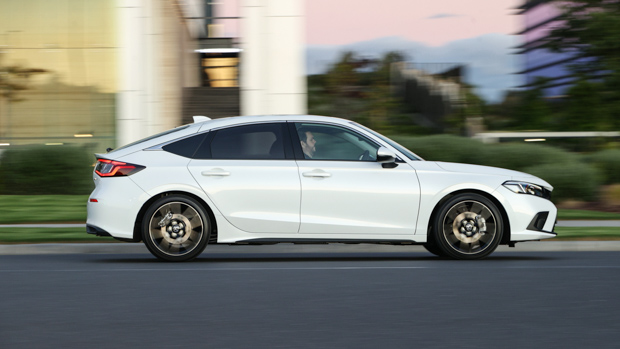
There are no adaptive dampers, but the ride quality is comfortable. Road noise – from the tyres especially – is much reduced compared to the previous Civic.
However, get yourself on a patch of classic, coarse-chip Australian country road at 100km/h and it’s still a bit intrusive. There remains room for improvement, especially now that the car costs $55,000.
Honda Australia says that the e-HEV LX is quicker from zero to 100km/h than its turbo petrol VTi LX sibling, however doesn’t quote any times. Honda Europe, though, quotes 7.8sec for the e-HEV while the VTi LX has been independently tested at 7.5sec.
The e-HEV feels a bit quicker owing to the instant torque of its electric motor, though power starts to taper off noticeably after about 60km/h.
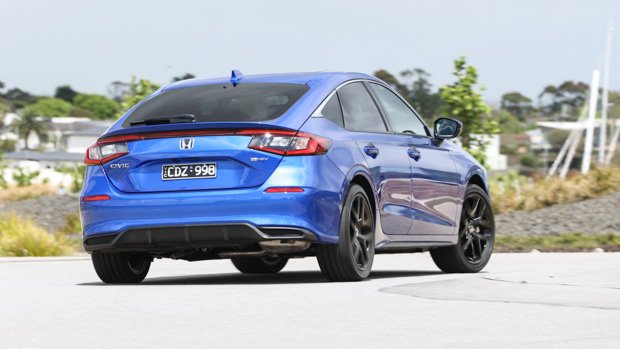
Find yourself on a winding road and the Civic e-HEV is surprisingly willing with exceptional dynamic ability. There’s plenty of grip front and rear, with great feel and excellent steering response.
The car feels close to the ground and wide, with a very sporty and low centre of gravity. It’s fun – and quite fast. A hot hatch from the 2000s would struggle to keep up. It’s possible to feel the (1497kg) e-HEV’s extra 128kg, especially in the rear – although it’s just as possible we were imagining it.
While the chassis sparkles in ways that make us froth over the incoming Type R, the powertrain isn’t quite as memorable.
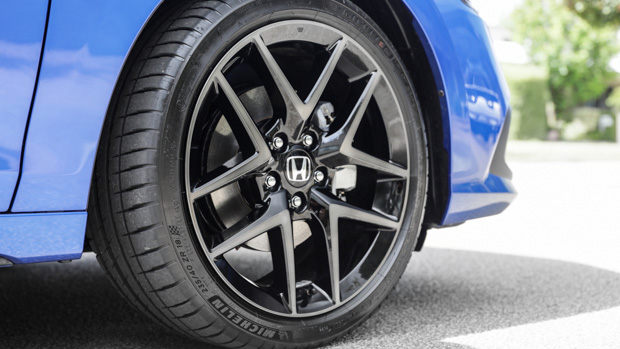
With its instant torque, the electric motor punches strongly out of low-speed hairpins, but that punch quickly fades.
The engine kicks in to recharge the battery and groans away almost reluctantly, the revs rising and falling with your throttle input but independent of the vehicle speed, with a sensation all the part like a CVT – meaning, somewhat blandly.
In Sport mode, there’s Active Sound Design, a synthetic soundtrack system that uses two front speakers to blast occupants with an artificial and quite loud engine noise that sounds sort of like a muted, 1990s Formula One car.
There are shift paddles on the steering wheel but they’re to scroll between braking regen modes. As the e-HEV has no transmission there are no gears to play with, not even artificial ones, even in Sport mode.
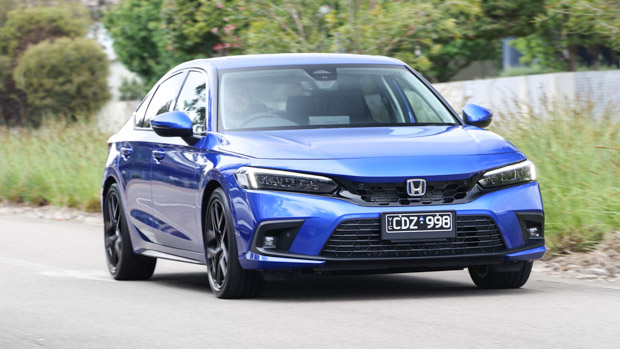
The Civic e-HEV displays battery charge level with a very prominent gauge within the instrument binnacle (like a fuel gauge) which made us think there was a dedicated battery recharging mode, and perhaps an EV-only mode.
Unfortunately not – the car switches between EV, hybrid and engine operation by itself. There are four modes the driver can choose from, however: Eco, Normal, Sport and Individual mode (which lets you mix engine modes, steering modes and digital instrument theme as per your desires).
Like the VTi LX, the e-HEV’s interior is a big step up on that of the previous 10th-generation Honda Civic, which looked like it was styled by a Japanese comic book artist.
The new, 11th-generation Civic interior is much more mature, although others would say it’s not as characterful as the old. You can’t win them all, but we like the new Civic’s interior a lot better than the old.
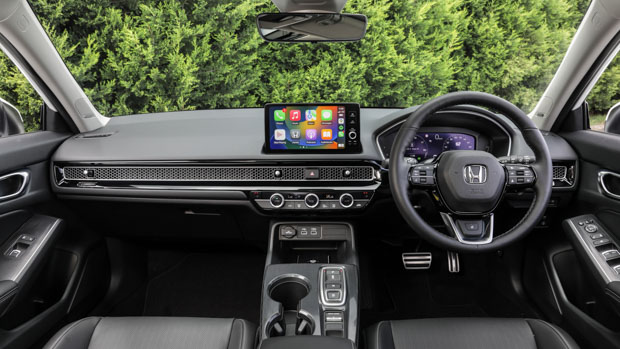
The build quality feels rock solid and the doors close with a lovely, heavy and tight thunk. It’s also a spacious place to be, more like a medium-sized car. The Civic is not a small car anymore and doesn’t feel much like one either.
Sitting proud atop the centre of the dash is a 9.0-inch infotainment display, the largest, says Honda, ever fitted to any of its vehicles. The software and menus are easy to use.
iPhone users can enjoy wireless Apple CarPlay, though Android owners will need to plug in their phone to access Android Auto, an issue we’ve also seen with rivals Mitsubishi and Nissan in their latest offerings.
Behind the steering wheel is a 10.2-inch TFT digital instrument display offering multiple displays. Graciously, there’s a digital speed readout nice and clear in the centre.
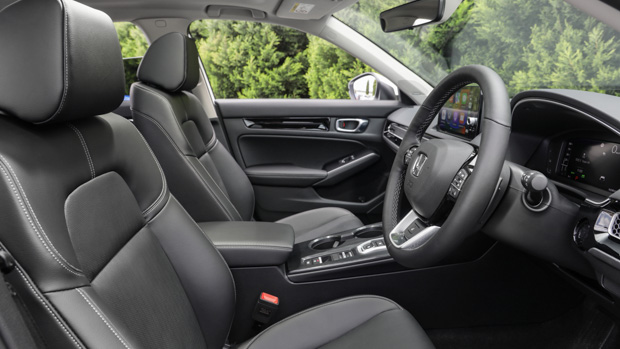
Up front, there’s a wireless phone charging pad, even if we couldn’t get it to work with our iPhone 12. There are two USB-A outlets up front, one with fast-charging capability.
The Civic e-HEV, like the VTi LX, comes with adaptive cruise control that’s paired with active lane keeping that allows auto-steering in short stints before chiming at you to put your hands back on the steering wheel.
One feature we love is Traffic Jam Assist, which puts the Civic into a semi-autonomous mode during – you guessed it – stop-start traffic, steering, accelerating and braking itself even to a stop. And Honda’s system works a treat.
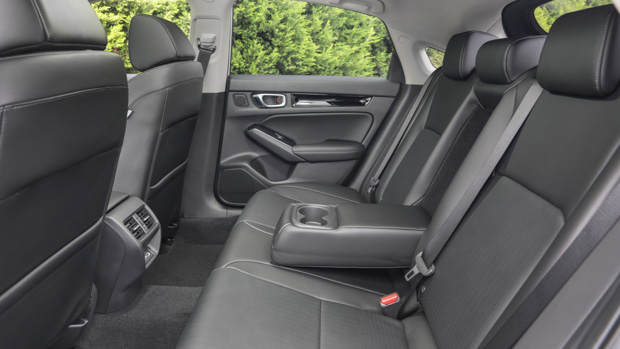
The back seat has two fast-charging USB-A outlets (no USB-C), two air vents with adjustable air-flow and a centre armrest with two cup holders. There was plenty of foot and knee-room for this tester (174cm tall), but anybody taller might find the headroom starting to get a bit tight.
At 409 litres with the rear seats up, the e-HEV has the same boot space as the VTi LX, though the latter does get an extra 40 litres of underfloor space owing to the additional hybrid gubbins, we presume.
One criticism we’ll level at the Civic is a lack of electric opening and closing tailgate – it’s manual only, and the hatch itself is hardly featherlight. At $55,000, it would have been a welcome addition.
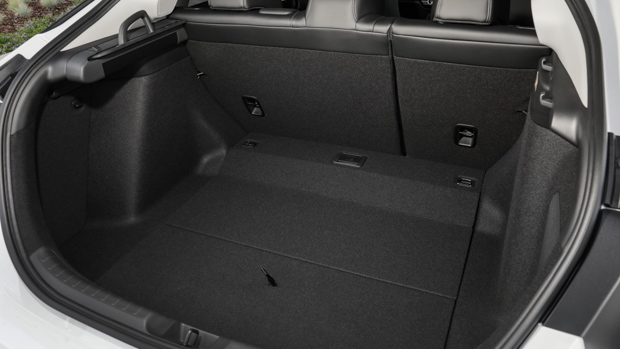
Honda hasn’t provided a vehicle to the Australasian New Car Assessment Program (ANCAP) for crash testing, but in its equivalent European program, Euro NCAP, the hybrid Civic recently scored the maximum five stars.
Both the Civic VTi LX and e-HEV LX come with the active Honda Sensing safety system, which provides everything from forward collision warning and AEB to lane departure warning and lane keep assist.
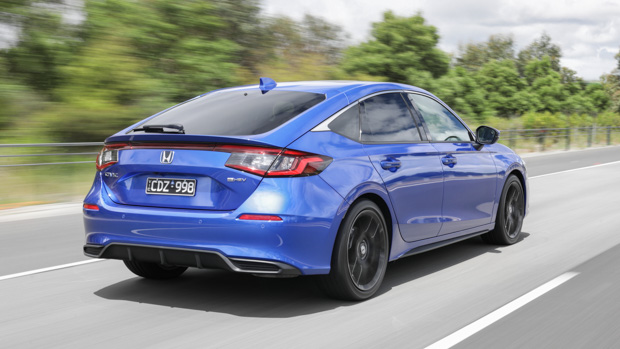
That said, the e-HEV LX builds on the VTi LX’s safety suite impressively, offering the additional safety features:
Honda’s Connect app also improves the e-HEV’s safety proposition over the VTi LX. In the event of an airbag deployment, the car will notify a Honda Connect Customer Care centre who will try calling you in the car.
As you’d hope for a hybrid vehicle, the e-HEV is cheap to run, at least in terms of how much fuel it uses. Honda claims 2.0L/100km in the city, which is remarkably low. During our test drive, we got an average of 4.7L/100km, which is close to its extra-urban claim of 5.5L/100km.
Many owners will compare the e-HEV to the VTi LX and wonder how long it might take to recoup the $7800 premium in fuel costs alone. Both cars run on the cheaper, lower octane 91RON – as opposed to the more expensive 95RON premium.
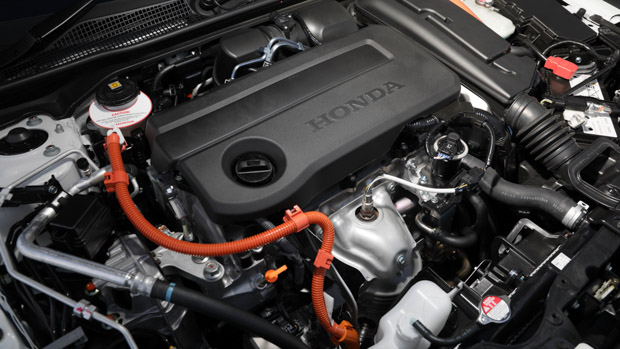
For the purposes of comparison, we’ll assume 91RON remains fixed at $2/litre and that the average driver is doing 13,000km per year.
If most of your driving is around the city (urban):
| Engine | Driveaway | 5 years fuel | 5 year spend |
| VTi LX 1.5-litre turbo 4cyl (8L/100km) | $47,200 | $10,400 | $57,600 |
| e-HEV 2.0-litre 4cyl hybrid (2.0L/100km) | $55,000 | $4160 | $59,160 |
If your driving is a mix of city/highway use (combined):
| Engine | Driveaway | 5 years fuel | 5 year spend |
| VTi LX 1.5-litre turbo 4cyl (6.3L/100km) | $47,200 | $8190 | $55,390 |
| e-HEV 2.0-litre 4cyl hybrid (4.2L/100km) | $55,000 | $5460 | $60,460 |
It’s probable that the e-HEV will hold its value better in the resale stakes after five years, offsetting the additional upfront cost somewhat.
Both cars cost the same amount to service – a very sharp $995 over five years, if you complete five services over five years, at 12-month or quite short 10,000km intervals.
The e-HEV also comes with Honda’s five-year, unlimited-kilometre warranty. Hondas also come with five years complimentary roadside assistance.
Five years complimentary Honda Connect is included in the e-HEV LX’s price, although Honda Australia hasn’t figured out yet how much it might cost when the subscription period ends as it’s still some time away. As it’s just a basic mobile data package, we can’t imagine too much.
Honda’s 11th generation Civic has surprising driver appeal, even if the powertrain doesn’t get the blood pumping quite the same way the chassis does. The Type R alternative, of course, promises to fix that.
What the e-HEV does offer is remarkable fuel economy and the feel of an electric vehicle at low speeds – and it makes a compelling case for itself over the VTi LX despite the $7800 premium.
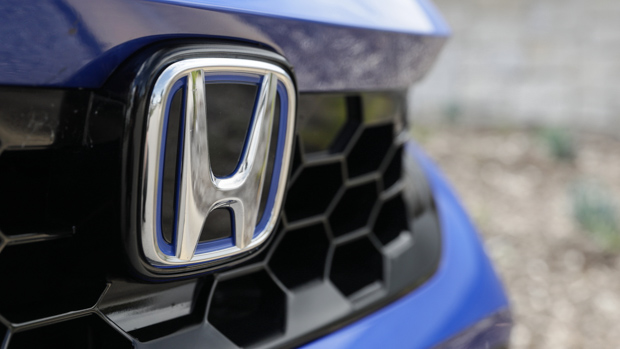
Some could argue the greener credentials of the e-HEV over the petrol VTi LX as well – its tailpipe CO2 emissions are about a third lower (96g/100km versus 148g/km).
However, that’s not factoring in the extra environmental impact of making a more complex vehicle with rare metals such as lithium – and then how it’s disposed of at the end of its life.
And if you are really interested in reducing your carbon footprint, you should probably just skip the whole hybrid thing and pay extra for a fully-electric vehicle.
If it is a hybrid you’re after – without the stress of having to recharge an EV – the e-HEV LX does appear pricey compared to rivals such as the Corolla ZR Hybrid sedan. While the Toyota’s 103kW/142Nm isn’t a patch on the e-HEV LX, its 3.9L/100km pips it somewhat, while its
$37,620 (list) is vastly more affordable.
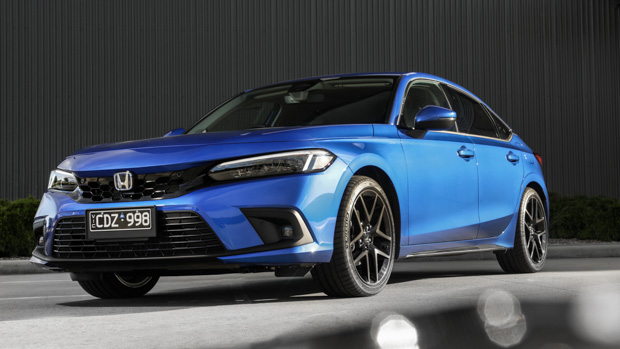
That said, the Civic e-HEV LX also beats the Corolla ZR Hybrid for standard equipment. And we dare say you could get into the Honda a bit quicker than the Toyota, which continues to be affected by supply chain issues.
At $55,000 driveaway, the e-HEV LX is getting very costly for a Honda Civic. But all things considered it does appear worth the extra coin over the VTi LX and represents a lot of car for the money – one you’re unlikely to be disappointed in. Especially if you find yourself on a winding road.
Correction, 22/12/22: we received updated fuel consumption numbers for the Civic hybrid, which were altered from 4.9L/100km to 5.5L/100km (extra-urban), and from 3.2L/100km to 2.0L/100km (urban). Additionally, a reference to the Civic having an extending function for the sun-visor was removed, as the vehicle does not, in fact, have this feature.
Variant tested e:HEV LX
Key specs (as tested)
About Chasing cars
Chasing Cars reviews are 100% independent.
Because we are powered by Budget Direct Insurance, we don’t receive advertising or sales revenue from car manufacturers.
We’re truly independent – giving you Australia’s best car reviews.
The estimate provided does not take into account your personal circumstances but is intended to give a general indication of the cost of insurance, in order to obtain a complete quote, please visit www.budgetdirect.com.au. Estimate includes 15%^ online discount.
^Conditions Apply
Budget Direct Insurance arranged by Auto & General Services Pty Ltd ACN 003 617 909(AGS) AFSL 241 411, for and on behalf of the insurer, Auto & General Insurance Company Limited(ABN 42 111 586 353, AFSL 285 571).Because we don’t know your financial needs, we can’t advise you if this insurance will suit you. You should consider your needs and the Product Disclosure Statement before making a decision to buy insurance. Terms and conditions apply.
Indicative quote based on assumptions including postcode , 40 year old male with no offences, licence suspensions or claims in the last 5 years, a NCD Rating 1 and no younger drivers listed. White car, driven up to 10,000kms a year, unfinanced, with no modifications, factory options and/or non-standard accessories, private use only and garaged at night.
^Online Discounts Terms & Conditions
1. Discounts apply to the premium paid for a new Budget Direct Gold Comprehensive Car Insurance, Third Party Property Only or Third Party Property, Fire & Theft Insurance policy initiated online on or after 29 March 2017. Discounts do not apply to optional Roadside Assistance.
2. Discounts do not apply to any renewal offer of insurance.
3. Discounts only apply to the insurance portion of the premium. Discounts are applied before government charges, taxes, levies and fees, including instalment processing fees (as applicable). The full extent of discounts may therefore be impacted.
4. We reserve the right to change the offer without notice.